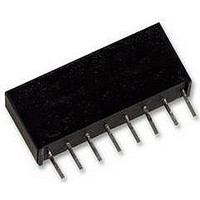THAT2181AL08-U THAT Corporation, THAT2181AL08-U Datasheet - Page 10

THAT2181AL08-U
Manufacturer Part Number
THAT2181AL08-U
Description
AMP, VOLT CONTROLLED, TRIMMABLE, 2181
Manufacturer
THAT Corporation
Datasheet
1.THAT2181AL08-U.pdf
(12 pages)
Specifications of THAT2181AL08-U
Brief Features
Exponential Gain Control, Wide Gain Range
Supply Voltage Range
± 4V To ± 18V
Operating Temperature Range
0°C To +70°C
Digital Ic Case Style
SIP
No. Of Pins
8
Operating
RoHS Compliant
Ic Function
Voltage Controlled Amplifier
Rohs Compliant
Yes
Document 600030 Rev 02
inherent noise modulation because of its class AB
biasing scheme, where the shot noise in the core
transistors reaches a minimum with no signal, and
increases with the square root of the instantaneous
signal current. However, in an optimum circuit, the
noise floor rises only to -94 dBV with a 50 μA rms
signal at unity gain — 4 dB of noise modulation. By
contrast, if a unity-gain connected, non-inverting
5534 opamp is used to directly drive the control
port, the noise floor will rise to 92 dBV — 6 dB of
noise modulation.
use quiet electronics throughout the control-voltage
circuitry. One useful technique is to process control
voltages at a multiple of the eventual control constant
(e.g., 61 mV/dB — ten times higher than the VCA
requires), and then attenuate the control signal just
before the final drive amplifier. With careful attention
to impedance levels, relatively noisy opamps may be
used for all but the final stage.
Stray Signal Pickup
ers to design circuit boards to minimize the pickup
of stray signals within the signal path. As with noise
in the control path, signal pickup in the control path
can adversely effect the performance of an otherwise
good VCA. Because it is a multiplier, the 2181
produces second harmonic distortion if the audio
signal itself is present at the control port. Only a
small voltage at the control port is required: as little
as 10 μV of signal can increase distortion to over
0.01%. This can frequently be seen at high frequen-
cies, where capacitive coupling between the signal
and control paths can cause stray signal pickup.
this problem can be difficult to diagnose. One clue to
the presence of this problem is that the symmetry
The 2181 Series VCAs have a small amount of
To avoid excessive noise, one must take care to
It is also common practice among audio design-
Because the signal levels involved are very small,
THAT Corporation; 45 Sumner Street; Milford, Massachusetts 01757-1656; USA
Tel: +1 508 478 9200; Fax: +1 508 478 0990; Web: www.thatcorp.com
Copyright © 2008, THAT Corporation
Page 10 of 12
null for minimum THD varies with frequency. It is
often possible to counteract a small amount of pure
fundamental picked up in the control path by
"misadjusting" the symmetry setting. Since the
amount of pickup usually varies with frequency, the
optimum trim setting will vary with frequency and
level. A useful technique to confirm this problem is
to temporarily bypass the control port to ground via
a modest-sized capacitor (e.g., 10 μF). If the distor-
tion diminishes, signal pickup in the control path is
the likely cause.
Temperature Sensitivity
2181 VCA is sensitive to temperature in proportion
to the amount of gain or loss commanded. The
constant of proportionality is 0.33% of the decibel
gain commanded, per degree Celsius, referenced to
27°>C (300°K). This means that at 0 dB gain, there
is no change in gain with temperature. However, at
-122 mV, the gain will be +20 dB at room tempera-
ture, but will be 20.66 dB at a temperature 10°C
lower.
temperature is of little consequence. However, if
necessary, it may be compensated by a resistor
embedded in the control voltage path whose value
varies with temperature at the same rate of 0.33%/°C.
Such parts are available from RCD Components, Inc,
www.rcd-comp.com, and KOA/Speer Electronics,
www.koaspeer.com.
Closing Thoughts
questions and suggestions regarding these devices,
their design and application. Our engineering staff
includes designers who have decades of experience in
applying our parts. Please feel free to contact us to
discuss your applications in detail.
As shown by Equation 1 (Page 5), the gain of a
For most audio applications, this change with
THAT
Corporation
Blackmer® Trimmable IC VCAs
welcomes
THAT 2181 Series
comments,














